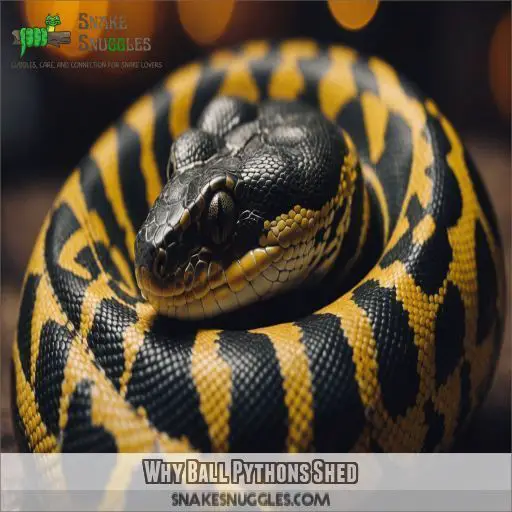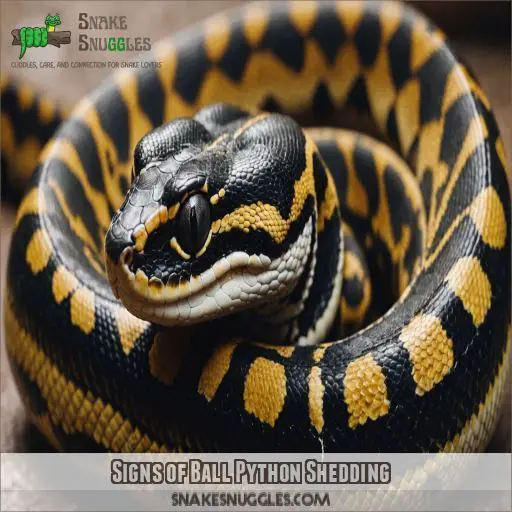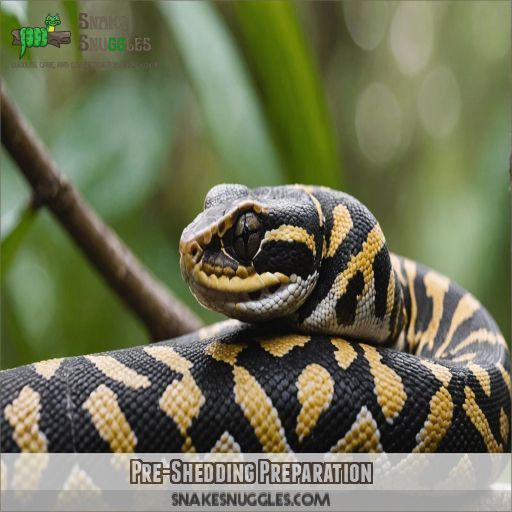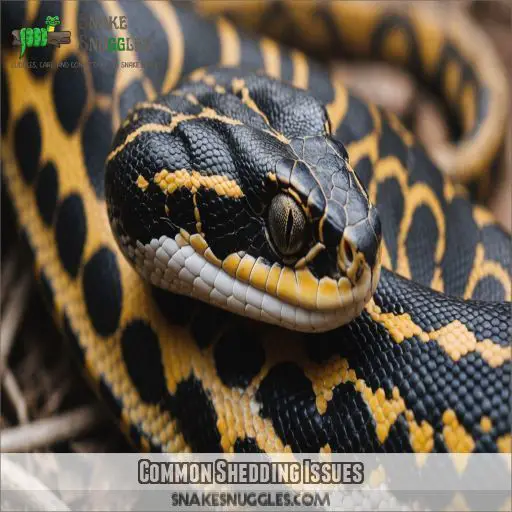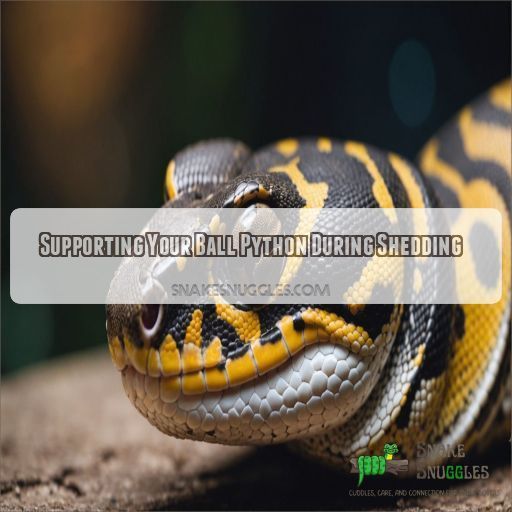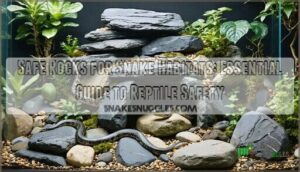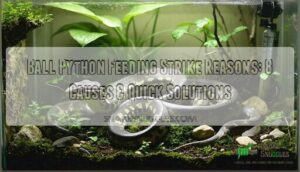This site is supported by our readers. We may earn a commission, at no cost to you, if you purchase through links.
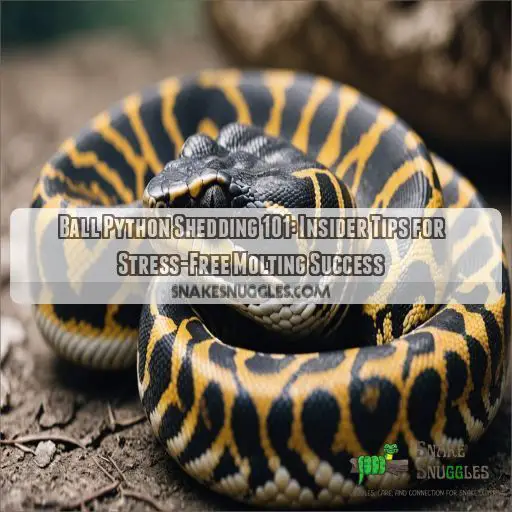 You’re probably no stranger to the sight of your ball python shedding its skin, but understanding why it happens can make all the difference in its health and happiness.
You’re probably no stranger to the sight of your ball python shedding its skin, but understanding why it happens can make all the difference in its health and happiness.
Ball pythons shed to accommodate growth, replace old skin, and respond to environmental factors – it’s a natural process that’s essential for their breeding readiness and overall lifespan.
As your ball python prepares to molt, you might notice behavioral changes like increased hiding or appetite loss, along with physical changes like milky blue eyes or dull scales.
Want to know how to support your pet through this process and avoid common shedding issues?
Table Of Contents
Key Takeaways
- As your ball python grows, it will shed its skin to accommodate its increasing size, replace old skin, and respond to environmental factors – think of it like upgrading to a bigger t-shirt!
- To support your ball python during shedding, maintain proper humidity (50-60%), provide a calm environment, and offer a variety of foods to cater to their dietary needs – it’s like setting up a spa day for your snake!
- Keep an eye out for common shedding issues like stuck sheds, incomplete shedding, skin infections, dehydration, and malnutrition – and don’t hesitate to consult a vet if you notice anything off.
- By understanding the ins and outs of ball python shedding, you can help your pet navigate this critical phase with ease, ensuring a happy, healthy, and stress-free life for your beloved snake – and that’s a pretty awesome feeling!
Why Ball Pythons Shed
As a ball python owner, you’re probably wondering why your pet is shedding its skin, and the answer lies in its natural growth and development process. Your ball python sheds its skin to accommodate its increasing size, replace old skin, and respond to environmental factors, and understanding these reasons will help you better support your pet during this critical process.
Growth and Development
As your ball python grows, it outgrows its skin, much like how you outgrow your favorite childhood t-shirt. During growth stages, your snake’s skin doesn’t stretch to accommodate its increasing size, so it sheds to accommodate the size increase. This process is essential for breeding readiness and overall lifespan, and is influenced by feeding habits and environmental factors.
Skin Replacement
As your ball python grows, its skin doesn’t. Imagine wearing the same outfit since birth – it’s time for a change! The shedding process allows your snake to replace its old skin with new, larger skin, ensuring a comfortable fit. This skin replacement is essential for maintaining skin health and supporting shedding cycles, which happen more frequently in younger snakes as explained in the shedding process.
Environmental Factors
Now that we’ve covered skin replacement, let’s talk about how your ball python’s environment affects shedding.
Temperature gradients, humidity levels, substrate type, enclosure size, and ventilation all play a role.
Think of it like preparing a relaxing spa day for your snake!
Make sure you have the right temperature and humidity ranges, and a spacious enclosure with good airflow for a stress-free shed.
Health Implications
When your ball python is shedding, it’s important to keep an eye out for health problems. Shedding issues can happen because of poor diet, stress, or skin infections. Parasites are also more likely to be a problem during this time. Make sure you’re watching your snake’s overall health and be ready to deal with any problems that come up.
Signs of Ball Python Shedding
As you care for your ball python, it’s important to recognize the signs of shedding to make sure your snake has a smooth experience. By knowing what to look out for, you can provide the right environment and support to help your ball python navigate this natural process with ease.
Behavioral Changes
As your ball python prepares to shed, you’ll notice some behavioral changes. Don’t worry, it’s like they’re saying, "I’m getting ready for a spa day, leave me alone!" You might observe:
- Increased hiding or seeking seclusion
- Lethargy or reduced activity
- Aggression or irritability
- Appetite loss or decreased interest in food
These changes are normal, but keep a close eye on your pet to make sure the shedding process goes smoothly.
Physical Changes
As your ball python prepares to shed, you’ll notice physical changes. Their eyes may turn a milky blue or gray, and their body may appear slightly swollen. Scales may become dull and dry, and they may even lose a bit of weight. Their tail length might appear shorter due to the skin contracting. These changes are normal, so don’t panic!
Changes in Appetite
As your ball python prepares to shed, you might notice changes in their appetite. Don’t worry, it’s normal for them to lose interest in food or even refuse meals altogether. This decrease in appetite is a natural response to the shedding cycle. Just make sure they’re staying hydrated and offer food again once the shedding process is complete.
Changes in Skin Color and Texture
As your ball python’s shedding cycle approaches, you’ll notice changes in skin color and texture.
Their skin may appear dull, pale, or develop a pinkish hue.
Texture differences can include softening, wrinkling, or a slight puffiness.
These pre-shed signs signal that your snake is preparing to molt.
Keep a close eye on these changes to help make sure the shedding process goes smoothly.
Pre-Shedding Preparation
Now that you’ve learned to recognize the signs of impending shedding, it’s time to get your ball python’s environment ready for a stress-free molt. By controlling humidity and temperature, providing a suitable shedding environment, and ensuring proper hydration and nutrition, you’ll be well-prepared to support your pet through this critical process.
Humidity and Temperature Control
Now that you’ve spotted the signs of shedding, it’s time to prep the environment. For a stress-free molt, you’ll want to tweak the humidity and temperature. Here’s your checklist:
- Maintain 50-60% humidity levels to prevent dehydration.
- Set up a temperature gradient with a warm spot around 85°F (29°C).
- Use an ideal thermostat to regulate the temperature.
- Choose gentle heating methods, like heat mats or ceramic heat emitters.
Providing a Shedding Environment
To create a stress-free shedding environment for your ball python, you’ll want to set up a shedding box with good humidity levels.
The ideal humidity level for a shedding box is around 60-80%.
Use a substrate that can hold moisture, like sphagnum moss.
Add some hide options, like a damp hide or a humidity cave, to help your ball python feel secure.
Make sure your enclosure setup allows for easy temperature and humidity adjustments.
Hydration and Nutrition
Now that you’ve set up a shedding-friendly environment, focus on your ball python’s hydration and nutrition.
Make sure they have access to fresh, clean water sources, and keep their hydration levels at a good level.
Meet their dietary needs with a balanced feeding schedule, and consider nutritional supplements if necessary.
Adjust food frequency according to their pre-shedding appetite changes.
A healthy snake is a happy shedder!
Monitoring Your Ball Python’s Health
As you prep for your ball python’s shedding, keep a close eye on their health. Monitor their weight, shedding frequency, and appetite. Stick to a regular feeding schedule and make sure the cage is clean. Schedule vet visits as needed. By staying on top of these factors, you’ll be better equipped to handle any shedding-related issues that arise.
Common Shedding Issues
You’ve prepped your ball python’s environment and are ready for shedding, but things don’t always go as planned – sometimes, your snake needs a little extra help to get through this process. In this section, we’ll cover common shedding issues you might encounter, from stuck sheds to skin infections, and provide practical advice on how to tackle them.
Dysecdysis (Stuck Shed)
You’ve prepped your ball python’s environment, but sometimes things don’t go as planned. Dysecdysis, or stuck shed, can occur due to dehydration, low humidity, or skin infections. Here are 4 common causes:
- Low humidity: If the environment is too dry, the shed skin can stick.
- Dehydration: Not enough water can cause skin to dry out.
- Skin infections: Bacterial or fungal infections can cause stuck shed.
- Poor nutrition: A diet lacking essential nutrients can lead to shedding complications.
Incomplete Shedding
Incomplete shedding can be a real stress-maker for you and your ball python. Causes include low humidity, inadequate temperature control, and poor nutrition. To prevent it, make sure you create a proper shedding environment and watch your snake’s health closely. If it happens, gently remove the stuck skin with a damp cloth, taking care not to cause complications or injury.
Skin Infections
When your ball python’s shedding doesn’t go as planned, skin infections can occur. Keep an eye out for symptoms like redness, swelling, or discharge. To prevent and treat skin infections:
- Maintain proper humidity and temperature
- Provide a clean environment
- Avoid handling your ball python excessively
- Monitor for signs of infection
- Consult a veterinarian for proper diagnosis and treatment
Dehydration and Malnutrition
During shedding, dehydration and malnutrition can creep up on your ball python. Make sure a clean, filled water bowl is always available. Monitor food quality and adjust as needed to prevent weight loss. Skin problems can arise from poor nutrition, so keep an eye out for signs of trouble. A healthy diet supports a smooth shedding cycle.
Supporting Your Ball Python During Shedding
Now that you’re familiar with common shedding issues, it’s time to focus on supporting your ball python during this critical process. By making a few simple adjustments to their environment and monitoring their health, you can help your pet snake shed successfully and reduce the risk of complications.
Maintaining Proper Humidity
To create the perfect environment for your ball python to shed its skin with ease, focus on humidity.
Aim for humidity levels between 50-60% during the shedding process.
You can achieve this by using a humid hide, which is a hide filled with moist sphagnum moss, or by misting your snake’s enclosure regularly.
Place a water bowl inside to help maintain moisture levels and give your snake a dip option.
Keep an eye on humidity levels with a gauge.
Too much or too little moisture can affect your snake’s shedding process, so it’s important to get it just right.
Providing a Calm Environment
As you focus on maintaining proper humidity, don’t forget to create a calm environment for your ball python. Provide a quiet space by minimizing handling and noise levels. Make sure the enclosure setup promotes relaxation, and establish a soothing nighttime routine. This stress reduction will help your pet navigate the shedding process with ease and confidence.
Offering a Variety of Foods
Now that you’ve got a calm environment set up, it’s time to think about food. Offer a variety of prey items to cater to your ball python’s dietary needs and preferences. Include a mix of lean and fatty foods, and consider adding nutritional supplements if necessary. Stick to a regular feeding frequency to minimize stress during shedding.
Monitoring for Health Complications
As your ball python sheds, keep a close eye out for health complications. Watch for shedding difficulties, like stuck skin, and signs of stress, such as labored breathing or lethargy. Also, monitor for eye issues, respiratory problems, digestive issues, or general health concerns. If you notice anything off, consult a vet ASAP to make sure your pet is safe.
Frequently Asked Questions (FAQs)
How often do ball pythons shed their skin completely?
You’ll be surprised to know that snakes shed their skin up to 12 times a year! As a ball python owner, you can expect your pet to shed its skin completely every 4-6 weeks, depending on its age and growth rate.
Can I handle my ball python during shedding season?
You’re wondering if it’s okay to handle your pet during shedding season. Generally, it’s best to minimize handling, as shedding can be a stressful and sensitive time for them, and excessive handling may cause irritation.
Do ball pythons eat less before shedding their skin?
It’s not unusual for ball pythons to go off their food before shedding their skin. Some owners notice their snakes become picky eaters or lose their appetite a few days before shedding.
How long does a ball python shedding cycle last?
You’re wondering how long this shedding cycle will last? Typically, it’s around 7-14 days, but it can vary depending on factors like your pet’s age, size, and environment. Keep a close eye on them, and they’ll be back to normal soon!
Can ball pythons get stressed from shedding their skin?
Think of shedding as a home renovation – it can be messy and stressful. Your ball python may get anxious or irritable during this process, so make sure to provide a calm environment and proper humidity to help them feel more comfortable.
Conclusion
As you watch your ball python slither out of its old skin, you can’t help but feel a sense of awe and wonder.
You’ve made it through the shedding process together!
By understanding the ins and outs of ball python shedding, you’ve helped your pet navigate this critical phase with ease.
With these insider tips, you’ll be well-equipped to support your ball python’s future molts, ensuring a happy, healthy, and stress-free life for your beloved pet.

